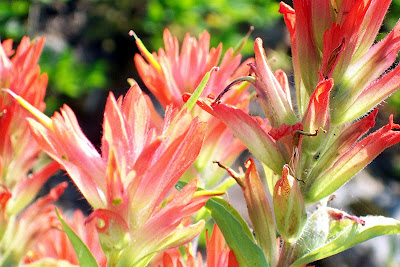Sunday, July 31, 2011
Distance: 6 miles out and back
Elevation Gain: 3278 ft
Highest Elevation: 6178 ft
 |
| Looking up snow clad ridge |
Anyone who has driven on Interstate 90 highway past Snoquamie Pass can not miss the imposing view of Snoqualmie Mountain sitting just to the north of the hairpin bend the highway takes at summit and beyond the nearby Guye Peak. Whenever I see it, I use to get an urge to one day scaling this peak.Despite the clouded sky, this was the day I walked on that trail. However, I found only one review of recent hike reported. This hiker picked up a wrong trail while climbing through an elevation of 500 ft before he realized the mistake. This report forewarned me of what it might be like if I am not paying attention on the trail.
 |
| Wild flowers! |
Unfortunately, in the haste of getting there and back on time for dinner with my neighbors Aryan and Julie to celebrate the birth of their newborn daughter Rayena, I forgot to pack my
Annual Northwest Forest Pass. This pass permits hikers to park inside any national forests in the states of Washington and Oregon. The Alpental trail head is a part of Mount Baker-Snoqualmie Nationa Forest.Since the pass I already have would cover me through end of October, I stoppled by the Snoqualmie Pass Visitor Center and picked up a
day pass just for the day today. I also looked for information on condition of the trail to my destination but there was not much to be had as not many seems to have gone there recently and reported.
 |
| Colorful new blooms |
The unmarked trail starts just south off of more popular and well marked Snow Lake trail. The trick to get to the correct trail is branching off onto a precariously unassuming side trail. Once after crossing a short stretch of colorful meadow, the trail climbs relentlessly over three quarter miles or so through a forested area and through an elevation of 1100 ft at the end of which there is a fork, the other leg leading to Guye Peak. There is a marker with directions of the two trails posted high above on a tree trunk. There can not be any mistake at this point about where the trail is heading.
 |
| Directions! |
After a short breather that leads across a stream with waterfalls on either sides, the trail resumes the relentless climb through thik forests for next half a mile. I encountered the first snow at an elevation of about 4800 ft inside that forested stretch. Pretty soon, the trail climbed onto a ridge with pebbles and dry ground where the forest gave way to short shrubs. As the trail gained more elevation, I started walking on large sheets of snow. Hereafter, the trail continues on the ridge all the way to the summit, passing on and off snow covers. There is supposed to be great views from the ridge on a sunny day.. But I was surrounded by so much of clouds and passing mists that I could catch only fleeting glimpses of nearby peaks and mountains. On trips to peaks, I always hope to catch sight of the distant Mount Rainier but this was not my day for that privilege.
I had my lunch of garden fresh cherry tomatoes, and cucumber, picked only this morning, and a home made sandwich while enjoying the serenity of my surroundings with ragged mountain tops just nearby peaking through dense mists passing by. I packed up a little while later and while heading back, met just one other hiker, and elderly gentleman going up that mountain. I vow to return another day to get my share of views from Snoqualmie Mountain!
 |
| Guye Peak and a piece of I-90 peeking through mists |
























